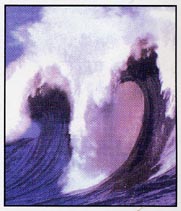Congratulations to my friend, artist John Pomara, for receiving a thumbs-up in Wired for a show he curated called "jet_seT." The exhibition, at the University of Texas at Dallas, deals with artists using new printing media, but contrary to the "art of the future" spin Wired typically puts on things, most of the folks he picked disrespect the technology quite a bit. This applies to content as well as form.  As Bret McCabe writes in his catalog essay: "Michael Odom's tweaking of online porn imagery, Angela White's twists of mundane looking family snapshots, Michelle Ganeles's mediated distortions, Jin-Ya Huang's processed images, and Reynaldo Thompson's distorted crowd photographs remind us that photography and digital imagery are merely manipulated representations of reality, not its actuality." I do have a question, though. According to McCabe, the large, breaking waves in Aaron Parazette's work are "entirely computer generated and have never occurred in nature." This gives the impression that they’re created in some simulation program, like the boiling seascapes in The Perfect Storm. I’d guess that they’re based on a normal photo of breakers, compressed horizontally to seem taller, but I’d like to know more about this body of work. As Bret McCabe writes in his catalog essay: "Michael Odom's tweaking of online porn imagery, Angela White's twists of mundane looking family snapshots, Michelle Ganeles's mediated distortions, Jin-Ya Huang's processed images, and Reynaldo Thompson's distorted crowd photographs remind us that photography and digital imagery are merely manipulated representations of reality, not its actuality." I do have a question, though. According to McCabe, the large, breaking waves in Aaron Parazette's work are "entirely computer generated and have never occurred in nature." This gives the impression that they’re created in some simulation program, like the boiling seascapes in The Perfect Storm. I’d guess that they’re based on a normal photo of breakers, compressed horizontally to seem taller, but I’d like to know more about this body of work.
|
Congratulations to my friend, artist John Pomara, for receiving a thumbs-up in Wired for a show he curated called "jet_seT." The exhibition, at the University of Texas at Dallas, deals with artists using new printing media, but contrary to the "art of the future" spin Wired typically puts on things, most of the folks he picked disrespect the technology quite a bit. This applies to content as well as form.
- tom moody 10-08-2002 5:47 am